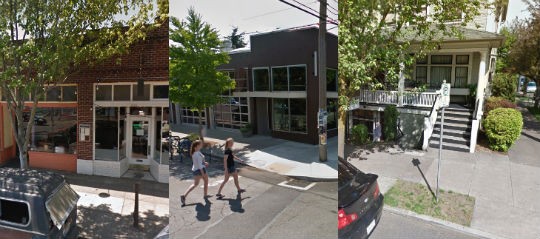
(Images: Google Street View)
In a splashy report on KGW.com last week, the much-loved Portland chef Andy Ricker of Pok Pok lamented the recent lack of off-street auto parking on the street where he built his fame.
Developers of Portland’s future Division Streets are “going to need to lose some commercial space to parking,” Ricker told the news channel.
If that were to be the case, it’d be a big shift for future players in Portland’s nationally famous restaurant scene. Of the 93 Portland restaurants in Willamette Week’s “Restaurant Guide 2015” list released this month, 74 — Pok Pok among them — chose to set up shop in buildings that don’t have any car parking at all.
Coincidence?
Of course, many or most customers at these restaurants drive to them. Though all these businesses draw foot, bike and transit traffic, all also rely on street parking, and in some cases on nearby paid garages or parking lots.
“All of the best places in Portland don’t have parking, and that’s part of what makes them great places.”
— Martin Cizmar, Willamette Week
But Ricker is right that street parking in Pok Pok’s neighborhood has become harder to find. So why are so many ambitious restaurants choosing to do business in exactly those spots? And why are they, to judge from Willamette Week’s enthusiasm, thriving despite the annoyances of parking nearby?
I asked Martin Cizmar, who edited Willamette Week’s restaurant guide, if his publication had perhaps disregarded restaurants in more auto-oriented areas because of his staff’s cultural links to the city center.
Just the opposite, Cizmar said.
“We’d really love to fuck with the urban elitists to tell them they have to drive to the suburbs to get any good food, but we could not in good conscience do that,” Cizmar said. “They just don’t have these kind of restaurants.”
Why not?
Advertisement
Cizmar offered two main reasons.
First, he said, people prefer to spend money in areas that aren’t dominated by car parking.
“All of the best places in Portland don’t have parking, and that’s part of what makes them great places,” he said. “They’re in walkable areas where you have lots of nice density that people like. … You can walk next door and get a cocktail with their meal, or walk down the street later and get dessert.”
Second, Cizmar said, buildings without parking are probably better-suited to entrepreneurship, because they allow new businesses to draw on the foot traffic of existing ones, and also because parking lots are so expensive.
“When you open a restaurant in an area that doesn’t have other restaurants and doesn’t have foot traffic, you’re taking a bigger risk,” he said. “If you find yourself a space on the edge of town that has a giant parking lot, you’re risking flaming out. And if you’re paying to rent a parking lot in addition to renting your space, you’re also taking on a huge amount of overhead. … It probably doesn’t pencil out for almost any restaurant to want to have a parking lot when that space could be put to better use.”
Even in relatively auto-oriented areas like NE 52nd and Sandy or SE 64th and Powell, small restaurants like Cabezon and Rose VL have set up in buildings that don’t have private parking.
Once you’re looking, in fact, it starts to seem as if Portland’s independent sit-down restaurants have been trying to locate anywhere except a building that has set aside some commercial space for parking. Even in relatively auto-oriented areas like NE 52nd and Sandy or SE 64th and Powell, small restaurants like Cabezon and Rose VL have set up in buildings that don’t have private parking. Nearby buildings with parking lots are home to regional or national chain stores like Gustav’s or 7-11.
Garrett Peck, general manager of Imperial, said that when he co-founded Willamette Week’s “Restaurant of the Year” parking was not a significant consideration.
The most important thing for Imperial, he said, was the number of potential customers within walking distance — in Imperial’s case, hotel patrons.
“We were looking to capture the hotel business,” he said. “There’s 1500 hotel rooms within a five-block area.”
Peck said he previously worked at Renata, a Southeast Portland restaurant that has an on-site parking lot. Renata, he said, pays quite a bit of rent for that lot, but it’s not nearly big enough to hold the restaurant’s patrons.
Dana McErlean, who owns two restaurants on the Willamette Week list, said that when she opened her first restaurant, Yakuza at 30th and Killingsworth, it was in a building she’d purchased herself in 1999. She rebuilt it into her home (upstairs) and into a restaurant on the ground floor.
She said she never considered adding a parking lot with that building. When she opened her next two restaurants within a block of that corner — DOC and Nonna, both on Willamette Week’s 2015 list — on-site parking wasn’t a consideration either, even though curbside parking in the neighborhood is far scarcer than it was in 1999. Her main motivation was building the value of each of her restaurants by creating a hub of other restaurants and businesses within easy walking distance of one another.
“There is a really large community that commutes by bike or public transportation,” she said. “Parking lots take a lot of space … if you’ve got to park a couple blocks away and walk somewhere, is it really a big deal?”
— Michael Andersen, (503) 333-7824 – michael@bikeportland.org
The Real Estate Beat is a regular column. You can sign up to get an email of Real Estate Beat posts (and nothing else) here, or read past installments here.
Correction 11:20 pm: The photo caption in an earlier version of this post gave the wrong street for Paley’s Place. It’s on NW 21st Avenue.


